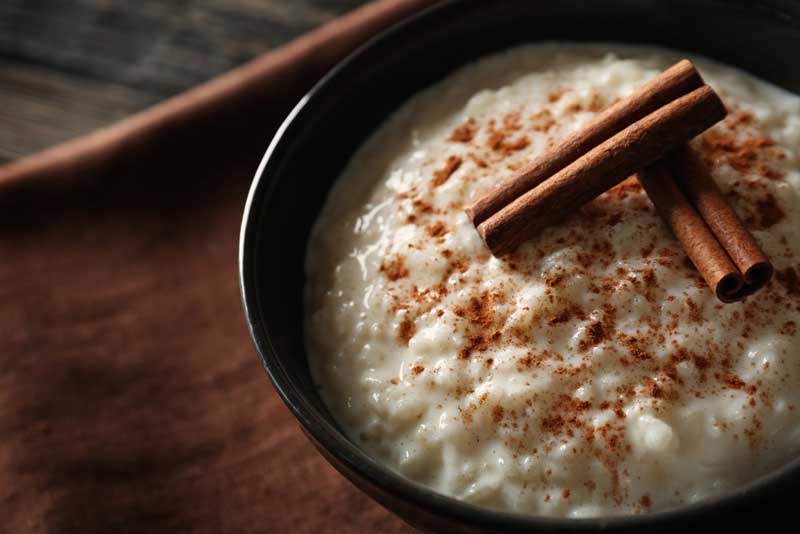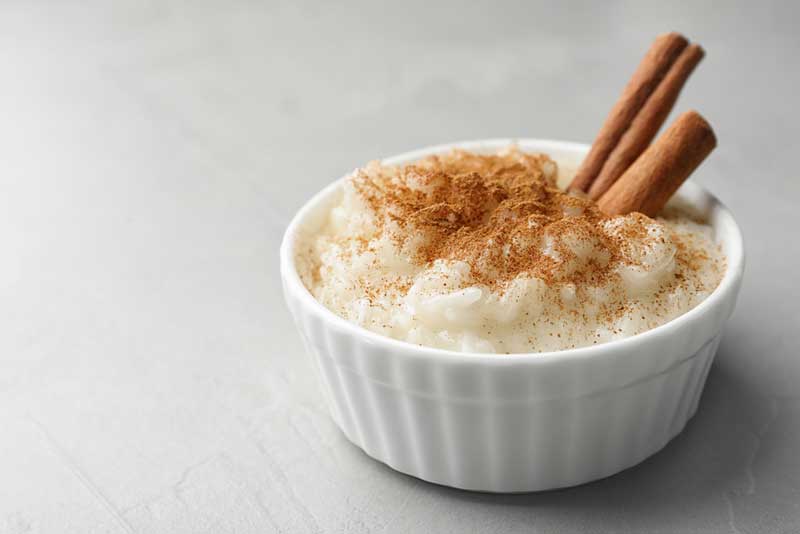What comes to your mind when you think of rice pudding? Most people who know it will think of a traditional comfort dish cherished for ages.
It boasts a delightful, creamy sweetness derived from milk, sugar, and rice and is sometimes enhanced with flavors like vanilla or cinnamon.
It is not a hidden fact that most people are concerned about the health impact of the food they take, and you are most likely one of them. Hence, the question: Is rice pudding good for you?
Join us as we delve into everything you need to know about rice pudding, including the nutritional aspects of rice pudding, to determine its suitability, thus enabling you to make an informed decision.
Rice Pudding: An Overview
Rice pudding, a creamy dessert prepared from sugar, milk, and rice, is often enhanced with cinnamon or vanilla and occasionally incorporates dried fruit like raisins. Across various cultures, it is a beloved comfort food frequently enjoyed as a snack or dessert.
Because it is primarily made from rice, it is perceived to be rich in carbohydrates. While that is not wrong, rice pudding surprisingly boasts a commendable protein content. To understand how much protein rice pudding contains, consider this: A serving made with whole milk and supplemented with protein powder can deliver as much as 8 grams of protein. Thus, if you are seeking additional protein intake while grappling with food tolerance issues, rice pudding will prove to be very advantageous.
Protein is often referred to as a foundational element in life due to its presence in numerous bodily fluids and holds notable significance for overall well-being. Ensuring a sufficient daily protein intake can yield favorable effects on health. This information should gladden you if you already enjoy rice pudding, as the recipe harmoniously combines proteins and carbohydrates, rendering it a versatile snack that you can enjoy before and after your workout.
Amplifying the appeal of this dish, an assortment of toppings such as cinnamon, toasted pecans, apple slices, sliced bananas, sliced bananas, or raisins can be incorporated, imparting a personalized touch to your rice pudding creation.
The beauty of this timeless dish lies in its comforting essence, which most people appreciate. Therefore, if you have never tried rice pudding before and you have an adventurous culinary preference, it’s worth considering making it a recurring indulgence.
Although people mostly enjoy rice pudding after a meal, there is no rule as to when you should have yours.
What Is Rice Pudding Made Of?
It is best to know what it is made with to gain a deeper insight into rice pudding. Not only does this information provide a deeper insight, but it also aids you to be able to make it on your own.
- Rice: Naturally, rice takes center stage in rice pudding. While any rice variety can be employed, short-grain rice is preferred due to its starch content, which contributes to the desired creamy texture. Longer-grain rice types are less effective since they release less starch.
- Milk: Next on the ranks after rice is milk. While your choice of milk is flexible, whole milk is commonly used for its rich and creamy texture and taste. Opting for skim or almond milk can yield a lighter dessert version without compromising flavor.
- Sugar: As with most foods with added sugar, it sweetens the rice pudding. While various sugars can be employed, white granulated sugar is the staple. However, brown sugar can be a suitable alternative if you desire a deeper caramel-like taste.
- Flavorings: Enhancing the rice pudding’s profile are flavorings. Popular options include cinnamon, vanilla extracts, cardamom, and nutmeg. However, vanilla extracts rank as the go-to choice. To further elevate the dish, you can incorporate dried fruits like raisins.
As you have seen, the components required to make rice pudding are not complex or scarce. What is more? Its versatility! You can use your own choice of any of the ingredients to make a unique rice pudding.
Also Read: Can You Eat Cold Chicken? (Answered) and Can you Freeze Banana Pudding? (Everything To Know)
Is Rice Pudding Good for You?
To help you answer the question, “Is Rice Pudding Good for You?” let us consider the health benefits of rice pudding.
- Rice pudding is a valuable source of wholesome carbohydrates and low in fat and sodium.
- Its nutritional profile boasts noteworthy quantities of calcium, vitamin B12, thiamin, and vital nutrients like magnesium, phosphorus, and potassium.
- Rice pudding’s fiber content contributes to prolonged satiety and supports a well-functioning digestive system. Because of this feature and its healthy fat content, rice pudding consumption might contribute to reducing cardiovascular risks like strokes and heart attacks.
- As a result of its carbohydrate content, rice pudding supplies one with the needed energy for physical and mental activities.
Undoubtedly, these benefits of rice pudding highlighted here show that rice pudding is good for you. Make sure to incorporate it in a balanced diet. Also, if you have health issues requiring abstaining from any of the ingredients in rice pudding, look for safer alternatives.
Rice Pudding Calories and Nutrition
Many people love desserts; if you like rice pudding, you are on a healthy path. Each serving of rice pudding has a variety of nutritional content based on the recipe and the brand. The regular recipe contains rice, whole milk, sugar, salt, vanilla extract, cinnamon, and preservatives. In this recipe, per cup serving has around 300 calories.
Per cup serving, rice pudding provides approximately 7 grams of fat, 8 grams of protein, 2 grams of fiber, 54 grams of carbohydrates, 14 grams of sugar, 0.4 milligrams of iron, and 150 milligrams of calcium.
To maintain heart health, it’s advisable to limit saturated fat intake to less than 13 grams daily, as the American Heart Association recommends. This lowers the potential of elevated lipid and cholesterol levels, contributing to heart disease. The good news is that rice pudding contains only 4 grams of saturated fat.
Making Rice Pudding Healthier

Undoubtedly, many people cherish this timeless dessert, rice puddings. However, it can sometimes be marred by unhealthy fats and high sugar levels. This can prove to be a challenge for eaters who want a healthier choice. There is good news! You can make your rice pudding healthier while preserving its delectable appeal.
- Rice: The choice of rice is pivotal in crafting rice pudding. If you want to increase your benefits when you eat rice pudding in the form of fiber and nutrients, choose brown rice rather than white rice. Furthermore, considering basmati rice is prudent, given its low glycemic index that helps mitigate abrupt surges in blood sugar levels.
- Fruits and Nuts: Another option to make your rice pudding healthier is incorporating fruits and nuts. Fruits and nuts elevate their taste and consistency and amplify their nutritional value. If you want some natural sweetness, contemplate introducing sliced bananas and fresh berries. For a satisfying crunch, experiment with adding chopped walnuts or almonds.
- Sugar: If you are concerned about the sugar content of your rice pudding but still want it to have a delightful and healthful taste, there exist alternatives to try. One such option entails employing honey as a natural sweetener. Substituting white sugar with honey allows for a reduction in added sweetness within the recipe. You can add a little salt to accentuate the ingredients’ innate sweetness.
- Milk: When considering milk choices for rice pudding, you have two alternatives to full-fat milk: skimmed milk or coconut milk. Coconut milk is a dairy-free alternative, infusing the dish with a distinctive flavor. Meanwhile, skimmed milk offers a low-fat option that retains the creamy texture needed for rice pudding.
Frequently Asked Questions – Is Rice Pudding Good for You?
Is Rice Pudding Good for Breakfast?
Rice pudding stands as a remarkably simple and delicious option for a health-conscious breakfast during meal preparation. You can whip up this delightful dish in just 25 minutes and a single pot.
What Is Rice Pudding Rich In?
Vitamins like vitamin B1 and Vitamin B2 and Minerals like magnesium and potassium are present in rice pudding. Other vitamins like K, E, D, B, and A, and minerals like zinc, iodine, and calcium are also present if cow milk is used.
Is Rice Pudding Good Before Bed?
Rice pudding holds remarkable comforting qualities, making it an excellent choice for a bedtime snack. Melatonin and Tryptophan are calming elements that contain rice pudding ingredients, thus helping you sleep better.
Also Checkout: How Long Is Ceviche Good For? (Explained) And How To Tell If Rice Is Bad (Full Details)
Conclusion- Is Rice Pudding Good for You?
When consumed in moderation and prepared using wholesome components, rice pudding holds the potential to serve as a healthful dessert alternative. Despite not being a low-calorie option, it offers vitamins and minerals like calcium, potassium, zinc, magnesium, iodine, and vitamins B1 and B2.
While it has plenty of health benefits, rice pudding has about 223 calories per serving, underscoring the importance of portion control. Fruits and raisins have natural sugar, helping you reduce added sugar. Cinnamon can be added to improve the taste without an influx of calories.
It’s worth noting that rice puddings differ. Store-bought variations contain excess sugars, artificial flavors, and additives that pose health threats. Hence, making your own rice pudding using suitable ingredients is advisable.
As we have seen, rice pudding is very beneficial to the human health. However, as with everything, it should be eaten in moderation. Make sure to incorporate it in a balanced diet. Also, if you have health issues requiring abstaining from any of the ingredients in rice pudding, look for safer alternatives.

